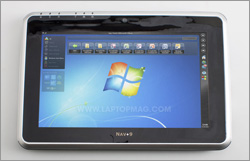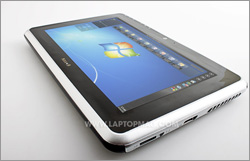Laptop Mag Verdict
This Windows enterprise tablet is marred by short battery life, a lackluster resistive touchscreen, and a high price.
Pros
- +
Pinch to zoom works fairly well
- +
Built-in webcam
- +
Three USB ports
- +
Case, car charger, VGA adapter, and SD card included
Cons
- -
Resistive touch screen not very accurate
- -
No accelerometer
- -
Sluggish performance
- -
Short battery life
- -
Stylus can't be stowed inside the tablet
Why you can trust Laptop Mag
Now that HP is targeting the business crowd instead of the masses with its Windows 7-powered Slate, it would seem that Netbook Navigator is in the right place at the right time. In fact, this reseller is beating HP to the punch with its Nav 9 Slate PC (starting at $599, $974 as configured), an 8.9-inch Windows 7 touchscreen device powered by an Atom processor. While the Nav 9 has some potential for on-the-go productivity, the battery life is short, the performance sluggish, and the touch experience downright frustrating. Is this tablet worth using even with a stylus?
Design
From afar, the Nav 9's rounded edges and flush battery make it seem like your standard Windows slab. Look closer, though, and you'll see that this tablet looks and feels far cheaper than its starting price. Take, for instance, the shiny plastic and the reflective bezel, or the resistive display, whose two layers have air bubbles trapped in between them. Let's just say that we disagree with Netbook Navigator's claim that the Nav 9 is the most attractive mobile computing device since the iPhone.
At 2 pounds, the Nav 9 is heavier than the 1.8-pound iPad, which has a larger display. However, because the Nav 9 has a narrower shape, it's easier to hold single-handedly. This slate is a bulky 0.8 inches thick but accommodates more ports than the iPad and other tablets.
The Nav 9 comes with a small silver stylus that's about as long as a matchstick, but there's not even a place on the tablet in which to stow it. Even the blue LED lights lining the top edge make this machine seem more like a netbook with its keyboard cut off than a modern slate.
Display and Sound
Thanks to the Nav 9's 1024 x 600 resolution, web pages fit the 8.9-inch screen nicely. Although the Nav 9 runs Windows, you'll have to install Flash yourself. Once you do, you can enjoy video from sites such as YouTube. When we played YouTube clips at full screen, the action was smooth but some colors appeared washed out. The viewing angles also weren't great. When we viewed the screen head on, we could easily watch videos, but if we laid it flat on a table or on our lap, or rotated it backward in our hands, the display's reflective finish became too distracting.
Likewise, music sounded tinny. When we listened to "Seven Nation Army" by The White Stripes, for example, we could barely make out the bass notes, which would normally sound prominent. Also, even when we cranked the volume in both Windows and in Slacker's player, the sound was still weak.
Tablet Experience

Click to enlarge
Although Netbook Navigator makes it clear that the Nav 9 is primarily aimed at enterprise customers, and is built for productivity over content consumption, it would still be impossible not to compare the Nav 9 to the more consumer-friendly iPad. The Nav 9 lacks an accelerometer, for one; it doesn't even have a button letting users manually readjust the orientation, as years-old tablets had.
Moreover, the screen is resistive, not capacitive. The difference is enormous, and is perhaps the biggest flaw sealing the Nav 9's fate as a tablet to avoid.
While we've seen some decent resistive touchscreens on other devices, the Nav 9's can be frustrating to use. In case the air pockets in between the resistive layers weren't enough of a red flag, we often had to tap multiple times, regardless of whether we were using a finger or the included stylus. Often, we accidentally selected objects we didn't mean to, such as the power options icon in the system tray, which is adjacent to the Wi-Fi indicator we had actually wanted to open.
Oddly, when it came to scrolling through webpages, we sometimes found it easier to drag our finger up and down than to drag the scroll bar with our stylus. Also, pinching and zooming worked surprisingly well, given how unresponsive the display could be when it came to simpler gestures, such as tapping.
The Nav 9 has an onscreen keyboard whose keys are too small to type on with anything other than the pen stylus. The Nav 9's onscreen keyboard was also sometimes sluggish in opening and in processing letters and numbers as we pecked away. Moreover, a glitch in the software leads it to spit out ".co" every time you press the ".com" button. Given how necessary the stylus is at times, it's not acceptable that you can't stow it inside the tablet; we imagine that many workers would lose it pretty quickly.
While to some extent the Nav 9's hardware is to blame for the poor tablet experience, it's also true that Windows 7 just isn't a finger-friendly OS. Netbook Navigator plans to release a more touch-friendly skin for Windows 7 by the end of the year, but for now users will be stuck poking at stock Windows 7 with a stylus or finger.
Ports and Webcam
The Nav 9 does have a good selection of ports, making it more expandable than the iPad. These include three USB ports, headphone and mic ports, an SD/MMC slot that doubles as a 3G SIM card slot, and an LAN port into which you can insert the included LAN-VGA adapter (more on bundled accessories later).

Click to enlarge

Click to enlargeThe Nav 9's 1.3-MP forward-facing webcam cast a bluish-green tint over our video, although it remained fluid and focused, even as we moved toward and away from the camera. The volume was very low, even though we were speaking very close to the tablet. While this won't matter to people who video chat via services such as Skype, the included webcam software doesn't have a user-friendly UI, and only lets you record video (and not take still photos).
Performance and Graphics
Our configuration of the Nav 9 had a 1.66-GHz Intel Atom N280 processor, 2GB of RAM, and 32GB flash drive. Despite having an SSD, this tablet's PCMark Vantage score of 1,218 hovers below the netbook category average of 1,291. Likewise, its Geekbench score of 864 fell just short of the netbook category average of 888. It's worth noting, too, that early netbooks used the N280 processor; new ones run on faster dual-core Atom processors, which explains why the Nav 9's benchmark scores are underwhelming. For what it's worth, Netbook Navigator says that Intel's Oak Trail processors are part of its roadmap of future products.
Finally, the Nav 9's 32GB flash drive transferred a 4.97GB mixed media folder in 5:50, or at a rate of 14.5 MBps, which falls short of the netbook average of 18.9 MBps. In our own use, we found that while the tablet never choked, it often paused between tasks. For instance, it took a couple seconds to open a video clip in Windows Media Player at full screen and, as we mentioned, text entry using the onscreen keyboard was often painstaking.
All in all, the performance is about what you can expect from a netbook, if not worse, because you don't have a keyboard to make typing easier.
The Nav 9's score of 138 on 3DMark06, a graphics benchmark, falls far below the category average of 296. However, videos from sites such as YouTube and MSNBC.com played smoothly at full screen.
Also, while the tablet felt cool underneath our fingertips, even after playing videos at full screen--the back only reached 90 degrees after playing a movie on Hulu for 15 minutes--the fan was consistently noisy.
Battery Life and Wi-Fi

Click to enlarge
To date, other manufacturers have voiced concerns that Windows is much more resource-intensive than other operating systems such as Android, and that Windows-based tablets will have much shorter battery life. MSI has even said it will not ship a Windows tablet until Intel releases its next generation of Atom processors, which promise to be more energy efficient.
Netbook Navigator wasn't so patient, and as a result, the Nav 9 has terrible battery life. It lasted just 2:47 on the LAPTOP battery test. Netbook Navigator says it plans to improve endurance in the future, in part by using Oak Trail processors.
While the Nav9's 802.11b/g Wi-Fi saw very good throughput at 15 feet from our access point (an average of 34.7 Mbps), its range was severely limited; we barely got a connection at 50 feet, and when we did, throughput averaged 0.3 Mbps.
Configurations
The Nav 9 comes with 16GB, 32GB, or 64GB of storage, and starts at $699, $799, and $949, respectively. The base version has 1GB of RAM, Wi-Fi, and Bluetooth 2.0, so you'll have to pay more for 2GB of RAM ($75) and 3G service ($100). That's how our 32GB model with 3G and 2GB of RAM ended up costing $974. Enterprise customers can purchase the base version without Windows 7 for $599.
Conveniently, Netbook Navigator bundles some accessories, including a brown leather case (it's not very attractive), an 8GB SD card, a VGA adapter, and a car charger. Netbook Navigator also throws in free shipping.
Software and Warranty
Thankfully, as a tablet that purports to target business users, the Nav 9 doesn't come with the arsenal of bloatware you'd expect on a consumer-friendly Windows machine. Other than a trial of Microsoft Office 2007 Enterprise, we didn't see any non-essential software on the list. Again, though, a more touch-friendly software layer would have helped, which the company is working on.
The Nav 9 comes with a one-year warranty. One of the few companies without 24/7 technical support, its phone lines are open Monday through Friday, 9am to 6pm EST.
Verdict
With so many negative predictions aimed at Windows tablets, we'd actually like to see one pleasantly surprise us with a good touch experience and long battery life. Sadly, the Netbook Navigator Nav 9 (starting at $599, $974 as configured) is not that tablet: Its inaccurate resistive touch screen, frustrating on-screen keyboard, and relatively slow performance all disappoint, as does the sub-three-hour battery life. If you or your business really wants to use a Windows 7-based tablet, you're probably much better off waiting for HP's own slate to arrive.
Netbook Navigator Nav 9 Slate PC Specs
| Brand | Netbook Navigator |
| CPU | 1.66-GHz Intel Atom N280 |
| Card Readers | SD Card |
| Company Website | http://www.netbooknavigator.com |
| Display Resolution | 1024x600 |
| Display Size | 8.9 |
| Graphics Chip | Intel GMA 945 |
| Has Bluetooth | Yes |
| OS | Windows 7 Home Premium (32-bit) |
| Ports | Headphone, Mic |
| RAM Included | 2GB |
| RAM Upgradeable | 2GB |
| Storage Drive Size | 32GB |
| Storage Drive Type | Flash Memory |
| USB Ports | 3 |
| Weight | 2 pounds |
| Wi-Fi | 802.11b/g |
Dana Wollman was a contributing writer at Laptop Mag. Her coverage included reviews of some of the most iconic laptops from the previous decade, such as the Dell XPS, Dell Studio, HP EliteBook, and MSI Wind. She focused on smaller netbooks and productivity-oriented devices. After Laptop Mag, Dana worked as an Editor-in-Chief at Engadget, and is now a Senior Technology Editor at Bloomberg.
